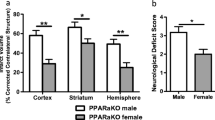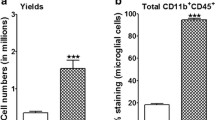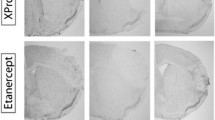Abstract
Inflammation involving migration of immune cells across the damaged blood–brain barrier (BBB), activation of resident innate microglia and production of inflammatory humoral mediators such as cytokines and chemokines play a critical role in the pathogenesis of ischemic stroke. Cell-cell signaling involved in the process also includes checkpoint interaction between programmed death receptor (PD1) and programmed death ligands, PDL1 and PDL2. Based on our previous studies showing reduced MCAO infarct volumes in PDL2 deficient mice, we evaluated the ability of anti-PDL2 mAb to treat MCAO in male and female C57BL/6 mice. We found that anti-PDL2 neutralizing antibody treatment of MCAO significantly reduced infarct volumes in male mice but had no protective effects in female mice even at a 5-fold increased dose of anti-PDL2 mAb. The protection in male mice was likely mediated by reduced percentages in the spleen of PDL2+CD19+ B cells, PDL1+CD4+ T cells and CD86+CD11b+ macrophages in concert with reduced expression of PDL1 and TNFα and continued expression of CD206, in the injured ipsilateral brain hemisphere. The lack of a therapeutic benefit of anti-PDL2 on stroke-induced infarct volumes in female mice was reflected by no detectable reduction in expressed PDL2 or PDL1 and an increased frequency of Th1 and Th17 pro-inflammatory T cell subsets in the spleen, an effect not seen in PDL2 mAb treated males. This result potentially limits the utility of anti-PDL2 mAb therapy in stroke to males but underscores the importance of meeting the STAIR requirements for development of new stroke therapies for both sexes.






Similar content being viewed by others
References
Agata Y, Kawasaki A, Nishimura H, Ishida Y, Tsubata T, Yagita H, Honjo T (1996) Expression of the PD-1 antigen on the surface of stimulated mouse T and B lymphocytes. Int Immunol 8:765–772
Alkayed NJ, Harukuni I, Kimes AS, London ED, Traystman RJ, Hurn PD (1998) Gender-linked brain injury in experimental stroke. Stroke 29:159–165 discussion 166
Banerjee A, Wang J, Bodhankar S, Vandenbark AA, Murphy SJ, Offner H (2013) Phenotypic changes in immune cell subsets reflect increased infarct volume in male vs. female mice. Transl Stroke Res 4:554–563. https://doi.org/10.1007/s12975-013-0268-z
Becker K, Kindrick D, Relton J, Harlan J, Winn R (2001) Antibody to the alpha4 integrin decreases infarct size in transient focal cerebral ischemia in rats. Stroke 32:206–211
Bodhankar S, Chen Y, Vandenbark AA, Murphy SJ, Offner H (2013) PD-L1 enhances CNS inflammation and infarct volume following experimental stroke in mice in opposition to PD-1. J Neuroinflammation 10:111. https://doi.org/10.1186/1742-2094-10-111
Chen L (2004) Co-inhibitory molecules of the B7-CD28 family in the control of T-cell immunity. Nat Rev Immunol 4:336–347. https://doi.org/10.1038/nri1349
Di Carlo A et al (2003) Sex differences in the clinical presentation, resource use, and 3-month outcome of acute stroke in Europe: data from a multicenter multinational hospital-based registry. Stroke 34:1114–1119. https://doi.org/10.1161/01.STR.0000068410.07397.D7
Dong H, Zhu G, Tamada K, Chen L (1999) B7-H1, a third member of the B7 family, co-stimulates T-cell proliferation and interleukin-10 secretion. Nat Med 5:1365–1369. https://doi.org/10.1038/70932
Francisco LM, Sage PT, Sharpe AH (2010) The PD-1 pathway in tolerance and autoimmunity. Immunol Rev 236:219–242. https://doi.org/10.1111/j.1600-065X.2010.00923.x
Greenwald RJ, Freeman GJ, Sharpe AH (2005) The B7 family revisited. Annu Rev Immunol 23:515–548. https://doi.org/10.1146/annurev.immunol.23.021704.115611
Hurn PD, Subramanian S, Parker SM, Afentoulis ME, Kaler LJ, Vandenbark AA, Offner H (2007) T- and B-cell-deficient mice with experimental stroke have reduced lesion size and inflammation. J Cereb Blood Flow Metab 27:1798–1805
Iadecola C, Anrather J (2011) The immunology of stroke: from mechanisms to translation. Nat Med 17:796–808. https://doi.org/10.1038/nm.2399
Ishida Y, Agata Y, Shibahara K, Honjo T (1992) Induced expression of PD-1, a novel member of the immunoglobulin gene superfamily, upon programmed cell death. EMBO J 11:3887–3895
Kleinschnitz C, Schwab N, Kraft P, Hagedorn I, Dreykluft A, Schwarz T, Austinat M, Nieswandt B, Wiendl H, Stoll G (2010) Early detrimental T-cell effects in experimental cerebral ischemia are neither related to adaptive immunity nor thrombus formation. Blood 115:3835–3842. https://doi.org/10.1182/blood-2009-10-249078
Latchman Y et al (2001) PD-L2 is a second ligand for PD-1 and inhibits T cell activation. Nat Immunol 2:261–268. https://doi.org/10.1038/85330
Li P et al (2013) Adoptive regulatory T-cell therapy protects against cerebral ischemia. Ann Neurol 74:458–471. https://doi.org/10.1002/ana.23815
Liesz A et al (2011) FTY720 reduces post-ischemic brain lymphocyte influx but does not improve outcome in permanent murine cerebral ischemia. PLoS One 6:e21312. https://doi.org/10.1371/journal.pone.0021312
Liesz A et al (2013) Boosting regulatory T cells limits neuroinflammation in permanent cortical stroke. J Neurosci 33:17350–17362. https://doi.org/10.1523/JNEUROSCI.4901-12.2013
Murphy SJ, McCullough LD, Smith JM (2004) Stroke in the female: role of biological sex and estrogen. ILAR J 45:147–159
Ren X, Akiyoshi K, Vandenbark AA, Hurn PD, Offner H (2011) Programmed death-1 pathway limits central nervous system inflammation and neurologic deficits in murine experimental stroke. Stroke 42:2578–2583. https://doi.org/10.1161/STROKEAHA.111.613182
Sharpe AH, Wherry EJ, Ahmed R, Freeman GJ (2007) The function of programmed cell death 1 and its ligands in regulating autoimmunity and infection. Nat Immunol 8:239–245. https://doi.org/10.1038/ni1443
Shichita T et al (2009) Pivotal role of cerebral interleukin-17-producing gammadeltaT cells in the delayed phase of ischemic brain injury. Nat Med 15:946–950. https://doi.org/10.1038/nm.1999
Subudhi SK et al (2004) Local expression of B7-H1 promotes organ-specific autoimmunity and transplant rejection. J Clin Invest 113:694–700. https://doi.org/10.1172/JCI19210
Sudlow CL, Warlow CP (1997) Comparable studies of the incidence of stroke and its pathological types: results from an international collaboration. International Stroke Incidence Collaboration Stroke 28:491–499
Tirilazad mesylate in acute ischemic stroke (2000) A systematic review. Tirilazad International Steering Committee. Stroke 31:2257–2265
Topalian SL, Drake CG, Pardoll DM (2012) Targeting the PD-1/B7-H1(PD-L1) pathway to activate anti-tumor immunity. Curr Opin Immunol 24:207–212. https://doi.org/10.1016/j.coi.2011.12.009
Yilmaz G, Arumugam TV, Stokes KY, Granger DN (2006) Role of T lymphocytes and interferon-gamma in ischemic stroke. Circulation 113:2105–2112
Zhang W, Davis CM, Edin ML, Lee CR, Zeldin DC, Alkayed NJ (2013) Role of endothelial soluble epoxide hydrolase in cerebrovascular function and ischemic injury. PLoS One 8:e61244. https://doi.org/10.1371/journal.pone.0061244
Zhou W et al (2013) Postischemic brain infiltration of leukocyte subpopulations differs among murine permanent and transient focal cerebral ischemia models. Brain Pathol 23:34–44. https://doi.org/10.1111/j.1750-3639.2012.00614.x
Zhu W et al (2010) Isoflurane preconditioning neuroprotection in experimental focal stroke is androgen-dependent in male mice. Neuroscience 169:758–769. https://doi.org/10.1016/j.neuroscience.2010.05.038
Zhu W, Dotson AL, Libal NL, Lapato AS, Bodhankar S, Offner H, Alkayed NJ (2015) Recombinant T-cell receptor ligand RTL1000 limits inflammation and decreases infarct size after experimental ischemic stroke in middle-aged mice. Neuroscience 288:112–119. https://doi.org/10.1016/j.neuroscience.2014.12.037
Zozulya AL, Ortler S, Fabry Z, Sandor M, Wiendl H (2009) The level of B7 homologue 1 expression on brain DC is decisive for CD8 Treg cell recruitment into the CNS during EAE. Eur J Immunol 39:1536–1543. https://doi.org/10.1002/eji.200839165
Acknowledgements
This work was funded by the American Heart Association grant 17GRNT33220001 (HO) and the Department of Veterans Affairs, Veterans Health Administration, Office of Research and Development, Senior Research Career Scientist Award 1IK6BX004209 (AAV). The contents do not represent the views of the Department of Veterans Affairs or the United States Government. The authors would like to acknowledge the following individuals for their contributions towards the completion of this manuscript: Dr. Gil Benedek, Gail Kent, Grant Gerstner, and Ha Nguyen.
Author information
Authors and Affiliations
Corresponding author
Additional information
Publisher’s note
Springer Nature remains neutral with regard to jurisdictional claims in published maps and institutional affiliations.
Rights and permissions
About this article
Cite this article
Seifert, H.A., Zhu, W., Vandenbark, A.A. et al. Sex differences in the therapeutic effects of anti-PDL2 neutralizing antibody on stroke. Metab Brain Dis 34, 1705–1712 (2019). https://doi.org/10.1007/s11011-019-00476-3
Received:
Accepted:
Published:
Issue Date:
DOI: https://doi.org/10.1007/s11011-019-00476-3




